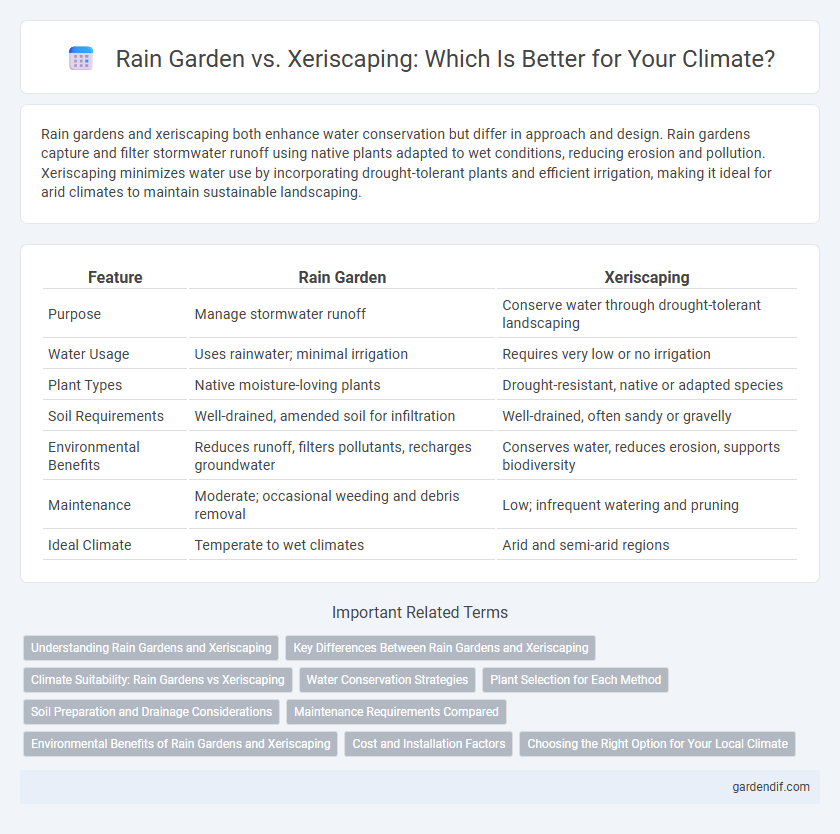
Rain garden vs Xeriscaping Illustration
Rain gardens and xeriscaping both enhance water conservation but differ in approach and design. Rain gardens capture and filter stormwater runoff using native plants adapted to wet conditions, reducing erosion and pollution. Xeriscaping minimizes water use by incorporating drought-tolerant plants and efficient irrigation, making it ideal for arid climates to maintain sustainable landscaping.
Table of Comparison
| Feature | Rain Garden | Xeriscaping |
|---|---|---|
| Purpose | Manage stormwater runoff | Conserve water through drought-tolerant landscaping |
| Water Usage | Uses rainwater; minimal irrigation | Requires very low or no irrigation |
| Plant Types | Native moisture-loving plants | Drought-resistant, native or adapted species |
| Soil Requirements | Well-drained, amended soil for infiltration | Well-drained, often sandy or gravelly |
| Environmental Benefits | Reduces runoff, filters pollutants, recharges groundwater | Conserves water, reduces erosion, supports biodiversity |
| Maintenance | Moderate; occasional weeding and debris removal | Low; infrequent watering and pruning |
| Ideal Climate | Temperate to wet climates | Arid and semi-arid regions |
Understanding Rain Gardens and Xeriscaping
Rain gardens are shallow, planted depressions designed to capture and infiltrate stormwater runoff, reducing erosion and recharging groundwater while supporting native vegetation. Xeriscaping is a landscaping method that minimizes water use by incorporating drought-tolerant plants, efficient irrigation, and soil amendments to maintain healthy soil moisture. Both strategies promote sustainable water management and climate resilience by optimizing landscape design to conserve water and mitigate urban heat effects.
Key Differences Between Rain Gardens and Xeriscaping
Rain gardens are designed to capture and filter stormwater runoff using native, water-tolerant plants, reducing erosion and improving water quality. Xeriscaping emphasizes drought-resistant landscaping with minimal irrigation, utilizing drought-tolerant plants to conserve water in arid climates. The key differences lie in their primary functions: rain gardens manage excess water, while xeriscaping focuses on water conservation through plant selection and soil management.
Climate Suitability: Rain Gardens vs Xeriscaping
Rain gardens thrive in regions with moderate to high rainfall, effectively managing stormwater runoff and improving groundwater recharge. Xeriscaping suits arid and drought-prone climates by utilizing native, drought-resistant plants to minimize water usage and maintain landscape health. Selecting between rain gardens and xeriscaping depends on local precipitation patterns, soil drainage, and water availability for sustainable climate adaptation.
Water Conservation Strategies
Rain gardens improve water conservation by capturing and filtering stormwater runoff, reducing the need for irrigation and preventing soil erosion through native plants that thrive in local rainfall patterns. Xeriscaping promotes water efficiency by utilizing drought-tolerant and low-water-use plants, minimizing irrigation requirements and conserving groundwater resources in arid climates. Both strategies enhance sustainable landscaping, but rain gardens primarily manage excess water, while xeriscaping focuses on reducing water demand.
Plant Selection for Each Method
Rain gardens utilize native, water-tolerant plants such as sedges, rushes, and wildflowers that thrive in moist, well-drained soil to effectively manage stormwater runoff. Xeriscaping emphasizes drought-resistant species like succulents, ornamental grasses, and deep-rooted shrubs adapted to arid conditions, reducing the need for supplemental irrigation. Selecting plants based on local climate and soil moisture levels enhances sustainability and water conservation in both landscaping approaches.
Soil Preparation and Drainage Considerations
Rain garden soil preparation prioritizes creating well-draining, nutrient-rich soil by incorporating organic matter and sand to enhance infiltration, preventing waterlogging during heavy rains. Xeriscaping requires soil amendments that improve water retention and reduce erosion, often utilizing mulch and native drought-tolerant plants to maintain moisture in arid conditions. Proper drainage design in rain gardens directs runoff into planted depressions, while xeriscaping emphasizes minimizing runoff through soil stabilization and efficient irrigation methods.
Maintenance Requirements Compared
Rain gardens require regular maintenance including watering, weeding, mulching, and monitoring drainage to ensure plant health and prevent erosion. Xeriscaping demands minimal upkeep, focusing on drought-resistant plants that thrive with little water and infrequent pruning. Both landscaping methods reduce water usage, but xeriscaping offers a lower maintenance option tailored for arid climates.
Environmental Benefits of Rain Gardens and Xeriscaping
Rain gardens effectively reduce stormwater runoff and improve water quality by filtering pollutants through native plants and soil, promoting groundwater recharge. Xeriscaping conserves water by utilizing drought-resistant plants and minimizing irrigation needs, significantly lowering overall water consumption in arid climates. Both strategies enhance urban biodiversity, reduce erosion, and mitigate heat island effects, contributing to sustainable landscape management and climate resilience.
Cost and Installation Factors
Rain gardens typically incur moderate installation costs due to soil excavation and planting native species that assist with stormwater management, while xeriscaping often requires lower upfront expenses by utilizing drought-tolerant plants and efficient irrigation systems. Installation of rain gardens involves detailed grading and soil amendments to ensure proper water infiltration, whereas xeriscaping emphasizes minimizing water use and maintenance through strategic mulch and rock placement. Both approaches offer cost-effective solutions, but rain gardens may entail higher labor and material investments compared to the more straightforward implementation of xeriscaping.
Choosing the Right Option for Your Local Climate
Rain gardens are ideal for regions with moderate to heavy rainfall, as they efficiently capture and filter stormwater runoff, reducing flooding and improving water quality. Xeriscaping suits arid and drought-prone climates by utilizing drought-tolerant plants, minimizing water use while maintaining landscape health. Selecting the right option depends on local precipitation patterns, soil type, and water availability to ensure sustainability and environmental benefits.
Rain garden vs Xeriscaping Infographic

 gardendif.com
gardendif.com